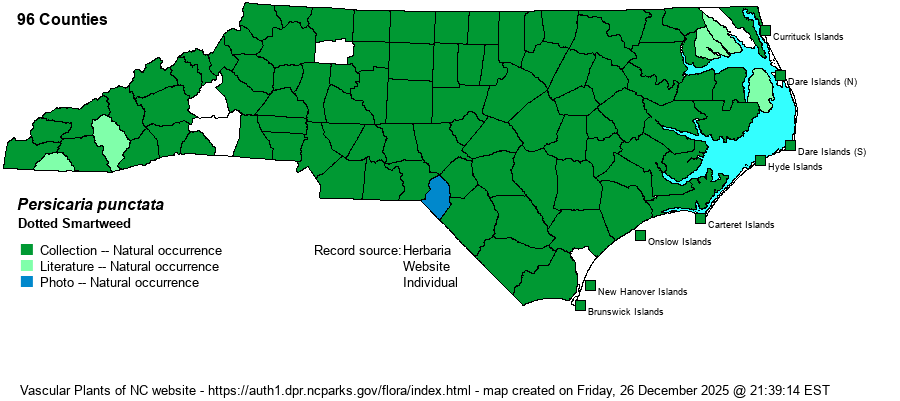| Author | (Elliott) Small | |
| Distribution | Throughout the state; no doubt in every county; oddly, few collections from the northeasternmost counties.
N.S. to Ont. and B.C., south to FL, TX, CA. Also Neotropics. | |
| Abundance | Common essentially throughout, often very common in much of the state. | |
| Habitat | Wet, fresh and fresh-tidal marshes, beaver ponds, impoundments, oxbow ponds, floodplain forests, bottomlands, interdune marshes. May occur in some wetland clearings, but seldom occurs in upland sites like a few other native species. | |
| Phenology | Flowering and fruiting July-November. | |
| Identification | Dotted Smartweed is one of several of our species which look similar in the field: erect stems 2-4 feet, with inflorescences terminal and from upper leaf axils. In this species, flowers are green and white (not pink or rosy), ocreae bristles are greater than 0.5 mm long, and sepals are pitted or punctate. Swamp Smartweed (P. hydropiperoides) is very similar, but sepals lack the little pits; that species tends to have a longer spike that has relatively few gaps in the spike with no flowers. Bog Smartweed (P. setacea) is usually taller, broader-leaved, thicker-stemmed, flowers bright white and showy, and it lacks pits on sepals; it also has a somewhat continuous spike of flowers, with few gaps. Dotted Smartweed is perhaps the most numerous of the many native (and common) smartweeds in the state, often occupying smaller wetlands than others and occurring in more places. It has a slender stem and is often leaning to ascending. It has the "skimpiest" spikes of the group, fairly long and quite narrow, often somewhat curved, with numerous and often wide gaps between the greenish white to white flowers. Spikes are oriented in many directions, many of them on a plant more or less horizontal, but some are ascending or erect. | |
| Taxonomic Comments | Formerly named as Polygonum punctatum.
Many species formerly treated in the genus Polygonum have been moved to Persicaria, the smartweeds. These are generally erect and tall plants with terminal and axillary floral spikes; most occur in wetlands. Others remain in Polygonum, the knotweeds, which are generally prostrate to ascending and with inconspicuous axillary flowers. They occur mostly in dry soils and tend to be weedy.
Attention must be paid to the small collars at the junction of the main stem and leaf stems (called ocreae) and whether they possess terminal hairs or bristles. Some keys also refer to the even smaller collars from which flowers emerge (called ocreolae). Another important ID character is the surface of the greenish sepals -- whether smooth or dotted with indentations (punctate). | |
| Other Common Name(s) | None | |
| State Rank | S5 | |
| Global Rank | G5 | |
| State Status | | |
| US Status | | |
| USACE-agcp | OBL link |
| USACE-emp | OBL link |

